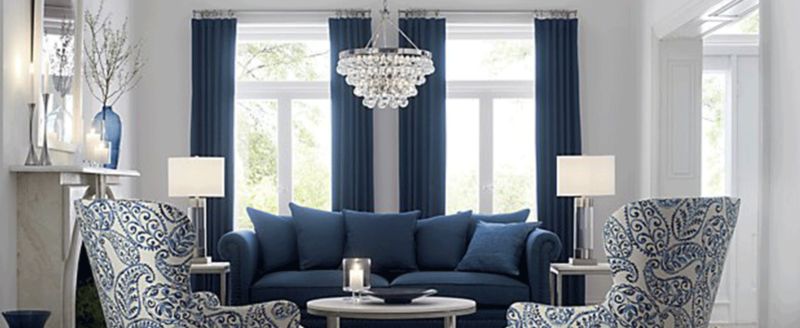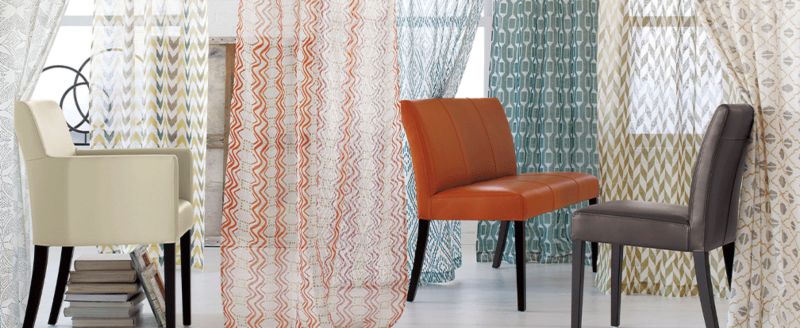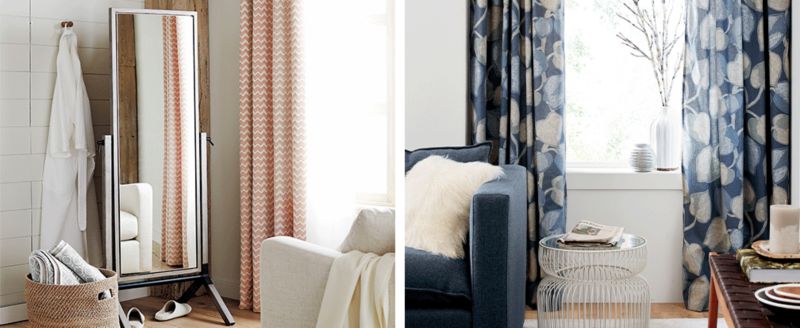Pictures of Different Ways to Hang Curtains
A Guide on How to Hang Curtains
You have the furniture, you have the decor...wondering what else rounds out the look of a room? Curtain panels, of course. Not only do these versatile window treatments offer privacy, insulation and noise reduction, they also come in a variety of materials, patterns and colors—enhancing the ambience of your space. In order to help you reap all these benefits and more, we've compiled a guide on how to hang curtains. Read on to discover proper measurements, our favorite hanging techniques and which panel style looks best in your home.

Curtain Styles
One of the most exciting things about curtain panels is that they come in all sorts of styles and designs. Before deciding where and how to hang them, it's important to find a look that complements the aesthetic of the room. Not sure where to begin? No worries. Remember to keep the following factors in mind when choosing the ideal curtain panels for your home.
Colors and patterns: curtain panels take up a large amount of visual space, and as a result, play a crucial role in the cohesiveness of a room. When looking for panels that best suit the area, be sure to keep existing color schemes and decor in mind. Hanging drapes in a room that features a neutral palette? Maintain a streamlined aesthetic with curtains in solid hues of white, black and grey. Or, take a different approach in a room with more whimsical accents—think colorful pillows, throw blankets and wall art—with panels in fun designs that include stripes, zig zags or ombre.
Size: no matter your design preference, it's important to keep in mind that curtain panels should always be at least double the width of your window (even if you intend to keep them open most of the time). Unsure of length as well? Go long. Panels that end up being too short interrupt the flow of the room's aesthetic and are more difficult to adjust.
Fabric: as with colors and patterns, curtain panels come in a variety of materials. The one that's best depends largely on your needs, personal style and the ambience you're trying to achieve. Five of the most commonly-used materials are described below.
- • Silk: a classic choice, this fabric introduces a sense of formality to your space. Silk drapes look particularly appealing if they're pleated or puddled on the floor. Lining them is important if you want more privacy, as this material is a bit transparent.
- • Cotton: versatile and easy to clean, cotton panels make a seamless transition from casual to formal. They come in many different colors and styles, though cotton tends to be a bit stiffer than other fabrics. Additionally, their opaque construction means you can use them with or without liners.
- • Linen: most often used in casual environments, linen's sheer and lightweight construction adds a breezy touch to the room.
- • Velvet: an opulent choice, the heavy weight of velvet drapes creates a luxurious touch to your window. Though not necessary, adding liners enhances the velvet's formality, especially when the drapes are pulled open.
- • Sheer: love letting natural light fitler in? Sheer curtain panels help keep the room bright. Like silk this material is quite transparent, which means you'll need to invest in liners if you want more privacy.

Taking Measurements
After deciding on the style of curtain that works best for you, the next step is figuring out where to position the rod, as well as how to measure it and the panels being put on display.
Measuring Width: Curtain Rods and Panels
Before getting started, it's important to keep in mind that curtain rods are more visually appealing when placed above and outside the window's molding. To make sure it's positioned properly, keep a pencil within reach as you work to leave light markings on the wall—ensuring evenness and the look you're trying to achieve.
If your goal is to make a room feel bigger and brighter, it's recommended that each end of the rod extend 3 to 6 inches beyond the frame of the window on each side. For rooms that are smaller or have multiple windows close together, consider hanging the curtain rods less wide to avoid a cluttered look. This also applies if there is artwork and other decor displayed on the wall. Either way, curtain panels look best when hanging higher up—making the ceiling appear taller.
Keep in mind that for the curtain panels themselves, they should be two to two-and-a-half times the width of the window in larger spaces, and one to one-and-a-half times the width of the window in smaller ones.
Pro Tips
- •It's important that the width of each panel extends a few inches beyond the window to cover part of the wall as well. This helps achieve a loose and breezy look that gives the illusion of wider windows.
- •Worried about a window that looks off-center? Don't be. Just make one end of the curtain rod slightly longer than the other to make up the difference.
- •Working with two corner windows? Hang a couple rods that meet in the corner—forming a 90-degree angle. Be sure to remove the finials where the rods meet and hang a curtain from each rod for a softer and more put-together look.

Measuring Height
Most experts agree on two things when it comes to determining the proper height of your curtain rod and panels. First, the placement of the rod should be in relation to the ceiling, not the window. Second, it's ideal that each curtain panel is long enough to just brush the floor—helping them stay in place, minimizing how dirty they get and making it easy to vacuum the floor.
The best way to figure out panel length is to measure from the floor up to where you plan on positioning the rod. Be sure to mark this spot with a pencil, then round up to the nearest panel size—the most common being 63", 84", 108" and 120". Generally, drapes that hover about ½ inch off the ground provide a crisp and clean aesthetic, while those that float a bit higher, think 2 to 3 inches, offer a more casual look. Going for a more romantic touch? Add 4 to 6 inches to allow for puddling on the floor.
Pro Tips
- •Be sure to pre-shrink and iron your curtain panels before determining the height at which they look best. Doing so minimizes shrinkage during future washes.
- •If trying to determine the best height for shorter panels, such as those found on cafe curtains, measure from the bottom of the window sill to a pencil mark made 4 to 6 inches above the window frame.

Hanging the Curtain Panels
With the rod and panel's dimensions figured out, it's time to begin the process of hanging your new curtains. Before getting too involved in the installation process, take a minute to make sure everything is just how you want it. The most efficient way to go about this is to enlist the help of a family member or friend. Just have them hold up one end of the curtain rod—with the panel of your choice attached—in front of your pencil marks on the wall. Then, take a look from multiple angles and take pictures on your phone for better visualizations. Once you're satisfied with the placement, start installing.
Pro Tips
- •Some ceilings are slightly sloped. If this is the case in your home, give the illusion of balance by hanging the curtain rod so that it follows the symmetry of the ceiling—the rod will appear to be level even if it isn't.
- •It's ok to give windows in the same room different treatments. For instance, mixing and matching patterns, materials and colors gives the room a fun touch.
- •Panels aren't going to work for every window, and that's ok. Windows that are near floor heaters, above countertops and other potential obstacles can be left as they are or fitted with custom drapes.

Accessorizing Your Window Treatments
Want to add a stylish touch to your window treatment? Opt for accessories, such as finials and brackets, that reflect your personal style. In addition, tie backs are a fun and easy way to subtly experiment with different looks in your home. Think rope ones that add a bit of texture, or others made of colorful ribbon. Either way, tie backs help filter more natural light into the room and give each panel an appealing swooping effect.
Pro tip: if using wall-mounted tie backs, be sure to install them two-thirds of the way down the window and make sure the hardware coordinates with the rod.
More than a practical home decor solution, hanging curtain panels is a fun and stylish way to make a statement in any room. Have you recently updated your window treatment? Show us how it looks at the hashtag #CrateStyle.
Pictures of Different Ways to Hang Curtains
Source: https://www.crateandbarrel.com/ideas-and-advice/hanging-curtain-panels-guide